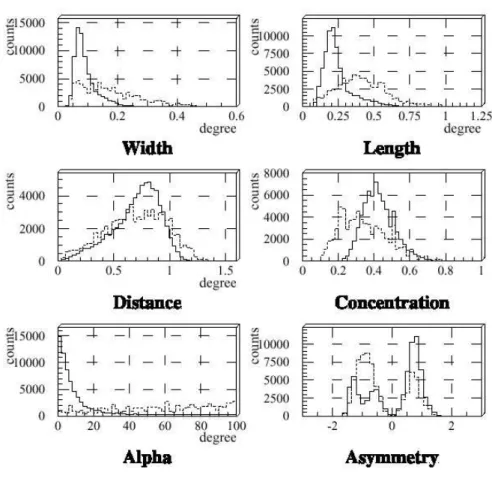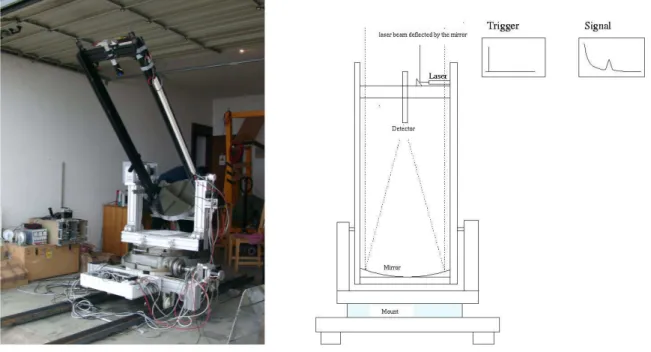Test of a Low-Power LIDAR for the Study of Temporarily Variable Transmission of the Atmosphere for Corrections in Groundbased γ-ray Astronomy with the 17m Cherenkov Telescope MAGIC
Volltext
Abbildung
![Figure 2.2: The CT1 telescope from the HEGRA telescope array, from [8]](https://thumb-eu.123doks.com/thumbv2/1library_info/4001554.1540525/17.892.188.716.163.569/figure-ct-telescope-hegra-telescope-array.webp)
![Figure 2.4: Schematic view of a neutron star, credits to NASA/CXC/SAO from [11]](https://thumb-eu.123doks.com/thumbv2/1library_info/4001554.1540525/18.892.289.621.439.768/figure-schematic-view-neutron-star-credits-nasa-cxc.webp)
![Figure 2.8: The refractive index as a function of height, Figure taken from [18]](https://thumb-eu.123doks.com/thumbv2/1library_info/4001554.1540525/23.892.211.700.159.535/figure-refractive-index-function-height-figure-taken.webp)
![Figure 2.9: The Cherenkov angle as a function of atmospheric height, Figure taken from [18]](https://thumb-eu.123doks.com/thumbv2/1library_info/4001554.1540525/24.892.195.703.156.533/figure-cherenkov-angle-function-atmospheric-height-figure-taken.webp)
ÄHNLICHE DOKUMENTE
If the raw blank is put onto a rotating plate, the final shape is a spherical surface of radius R according with the formula: R = sin r ϑ where r is the radius of curvature of
In this work we intend to provide a quantitative estimate of the MAGIC capabilities in observing GRBs, taking into account the main constraints which influence GRB observation which
† In the telescope, 162 m long optical fibers are used, instead of the 2 m long fibers utilized in this setup. However, no additional effects are expected due to the tiny attenuation
The analog signals are transmitted via optical fibers to the electronics hut where they are stretched, split into high and low gain channels and digitized with 300 MHz 8 bit Flash
The MAGIC (Major Atmospheric Gamma Imaging Cherenkov) Telescope was designed in 1998 [1] with the main goal of being the Imaging Atmospheric Cherenkov Telescope (IACT) with the
Ratio of L2T accepted events with a discriminator threshold of 6 phe , to the L1T accepted events with an higher discriminator threshold (8 phe ) as a function of energy, for
where T parameterizes the combination of intrinsic arrival time spread of the photons from the light pulser and the transit time spread of the PMT, T parameterizes the
In the MAGIC telescope the measure of the absolute time is provided by a high-precision atomic clock (Rubclock), formed by a Rubidium standard frequency oscillator in conjunction with
![Figure 2.10: The number of electrons in an electromagnetic air shower for different energies of the primary particle [19], Figure taken from [18]](https://thumb-eu.123doks.com/thumbv2/1library_info/4001554.1540525/25.892.217.707.177.516/figure-electrons-electromagnetic-different-energies-primary-particle-figure.webp)

![Figure 3.5: Polar mie scattering diagrams [27]. The size parameter x = 2πa/λ is shown for each diagram](https://thumb-eu.123doks.com/thumbv2/1library_info/4001554.1540525/38.892.135.786.343.1008/figure-polar-scattering-diagrams-size-parameter-shown-diagram.webp)
![Figure 4.2: Saharan sand carried by wind to the Canary Islands, Credits to ESA and NASA, taken from [34] and [35]](https://thumb-eu.123doks.com/thumbv2/1library_info/4001554.1540525/42.892.185.722.165.402/figure-saharan-carried-canary-islands-credits-nasa-taken.webp)
![Figure 4.5: Comparison of vertical temperature profiles for Tenerife and the U.S. Standard Atmo- Atmo-sphere and some averages of different latitudes for different seasons[40]](https://thumb-eu.123doks.com/thumbv2/1library_info/4001554.1540525/45.892.136.768.185.594/comparison-vertical-temperature-tenerife-standard-different-latitudes-different.webp)
